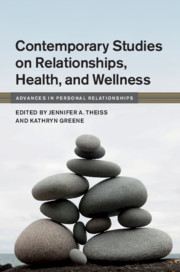Book contents
- Contemporary Studies on Relationships, Health, and Wellness
- Advances in Personal Relationships
- Contemporary Studies on Relationships, Health, and Wellness
- Copyright page
- Dedication
- Contents
- Figures
- Tables
- Contributors
- Acknowledgments
- Introduction
- Part I Interpersonal Influence in Health and Relationships
- Part II Information Management in Health and Relationships
- 4 Health-Related Issues That Individuals with Type 2 Diabetes Avoid Discussing with Their Romantic Partner
- 5 Closeness, Recipient Response, and Interaction Effectiveness: An Application of the Actor–Partner Interdependence Model in Mental Health Disclosures
- 6 From the Drawing Board to the Kitchen Table: An Analysis of Parental Messages Concerning Nutrition, Physical Activity, and Weight
- Part III Uncertainty in Health and Relationships
- Part IV Support and Caregiving in Health and Relationships
- Part V Communication Patterns in Health and Relationships
- Epilogue
- Index
- References
4 - Health-Related Issues That Individuals with Type 2 Diabetes Avoid Discussing with Their Romantic Partner
from Part II - Information Management in Health and Relationships
Published online by Cambridge University Press: 09 November 2018
- Contemporary Studies on Relationships, Health, and Wellness
- Advances in Personal Relationships
- Contemporary Studies on Relationships, Health, and Wellness
- Copyright page
- Dedication
- Contents
- Figures
- Tables
- Contributors
- Acknowledgments
- Introduction
- Part I Interpersonal Influence in Health and Relationships
- Part II Information Management in Health and Relationships
- 4 Health-Related Issues That Individuals with Type 2 Diabetes Avoid Discussing with Their Romantic Partner
- 5 Closeness, Recipient Response, and Interaction Effectiveness: An Application of the Actor–Partner Interdependence Model in Mental Health Disclosures
- 6 From the Drawing Board to the Kitchen Table: An Analysis of Parental Messages Concerning Nutrition, Physical Activity, and Weight
- Part III Uncertainty in Health and Relationships
- Part IV Support and Caregiving in Health and Relationships
- Part V Communication Patterns in Health and Relationships
- Epilogue
- Index
- References
- Type
- Chapter
- Information
- Publisher: Cambridge University PressPrint publication year: 2018



